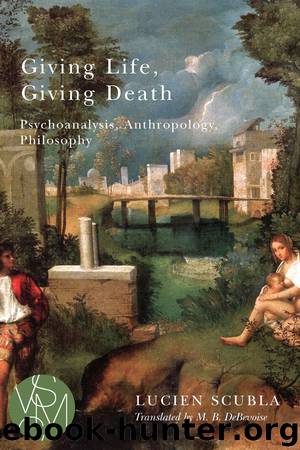Giving Life, Giving Death: Psychoanalysis, Anthropology, Philosophy by Unknown

Author:Unknown
Language: eng
Format: epub
ISBN: 9781628952674
Publisher: Michigan State University Press
CHAPTER TWELVE
Ethnology and Psychology in Róheim and Devereux
Identity, Homology, or Complementarity?
In spite of a deep acquaintance with ethnography, Freud’s disciples almost invariably aggravated the defects of their master—not only, as we have seen, through a dogmatic application of the Oedipus theory, but also on account of a psychologism that frequently was more pronounced than Freud’s own. The work of Géza Róheim, in particular, often seems to verge on caricature.
This is all the more striking because his writings have undeniable virtues. A scholar of vast learning and sound training, Róheim had a huge capacity for work, attested by his extensive field research among a great variety of peoples, the source in turn of a great many publications over the course of a long career. Even if his primary interest was in establishing that Hungarian folklore convincingly illustrates the grand themes of psychoanalysis, his very first article, accepted by a major international journal, presented a case of ritual regicide that had escaped the notice of even so erudite a scholar as Frazer, in a sober style devoid of any reference to Freudian theory (see Róheim 1915). Later, turning his attention to the social organization of Australian aboriginal peoples and the agricultural calendar of the inhabitants of Normanby Island in New Guinea, he revealed his own gift for precise observation and technical analysis. But he chose not to dwell on such topics. Once he had rapidly sketched the natural environment and social institutions of a particular population, he concerned himself almost exclusively with the rearing of children, the sexual life of young people and adults, the dreams of his informants, and the myths that they recounted to him. Everywhere he found the same things; everywhere he gave the same type of interpretation. This, he would have said, was because human nature is everywhere the same. Perhaps so—but it is also because his analytical framework acts as a selective filter. Even when the explanation he proposes seems plausible, one remains a bit doubtful, for it could not be more plain that the ethnographic materials he assembles, like Rorschach’s ink blots, are valued mainly as evidence in favor of his own theoretical presuppositions and personal obsessions. I shall limit myself to two examples of this tendency, 1 simple and persuasive, drawn from the introduction to a rather large book that Róheim ([1950b] 1968) published three years before his death.
The cavalier fashion in which he treats a famous tale of the Brothers Grimm, “Hansel and Gretel,” is particularly instructive (see ibid., 4). It recalls, in an extreme way, the manner in which Freud himself truncates the Oedipus myth and inverts its dynamics. Róheim summarizes the principal phases, but he omits altogether the tale’s point of departure: the abandonment of the two children, to which their father reluctantly agrees at his wife’s insistence. After several days of wandering the two children arrive at the home of a wicked witch, manifestly a double of the evil mother, who offers them shelter and food in order to lure them inside and make a meal of them.
Download
This site does not store any files on its server. We only index and link to content provided by other sites. Please contact the content providers to delete copyright contents if any and email us, we'll remove relevant links or contents immediately.
Rewire Your Anxious Brain by Catherine M. Pittman(18491)
Talking to Strangers by Malcolm Gladwell(13135)
The Art of Thinking Clearly by Rolf Dobelli(10142)
Mindhunter: Inside the FBI's Elite Serial Crime Unit by John E. Douglas & Mark Olshaker(9107)
Becoming Supernatural by Dr. Joe Dispenza(8040)
Change Your Questions, Change Your Life by Marilee Adams(7567)
The Road Less Traveled by M. Scott Peck(7475)
Nudge - Improving Decisions about Health, Wealth, and Happiness by Thaler Sunstein(7461)
The Lost Art of Listening by Michael P. Nichols(7360)
Mastermind: How to Think Like Sherlock Holmes by Maria Konnikova(7164)
Enlightenment Now: The Case for Reason, Science, Humanism, and Progress by Steven Pinker(7085)
Win Bigly by Scott Adams(7033)
The Way of Zen by Alan W. Watts(6452)
Daring Greatly by Brene Brown(6369)
Big Magic: Creative Living Beyond Fear by Elizabeth Gilbert(5557)
Grit by Angela Duckworth(5449)
Ego Is the Enemy by Ryan Holiday(5228)
Men In Love by Nancy Friday(5114)
Altered Sensations by David Pantalony(5006)
